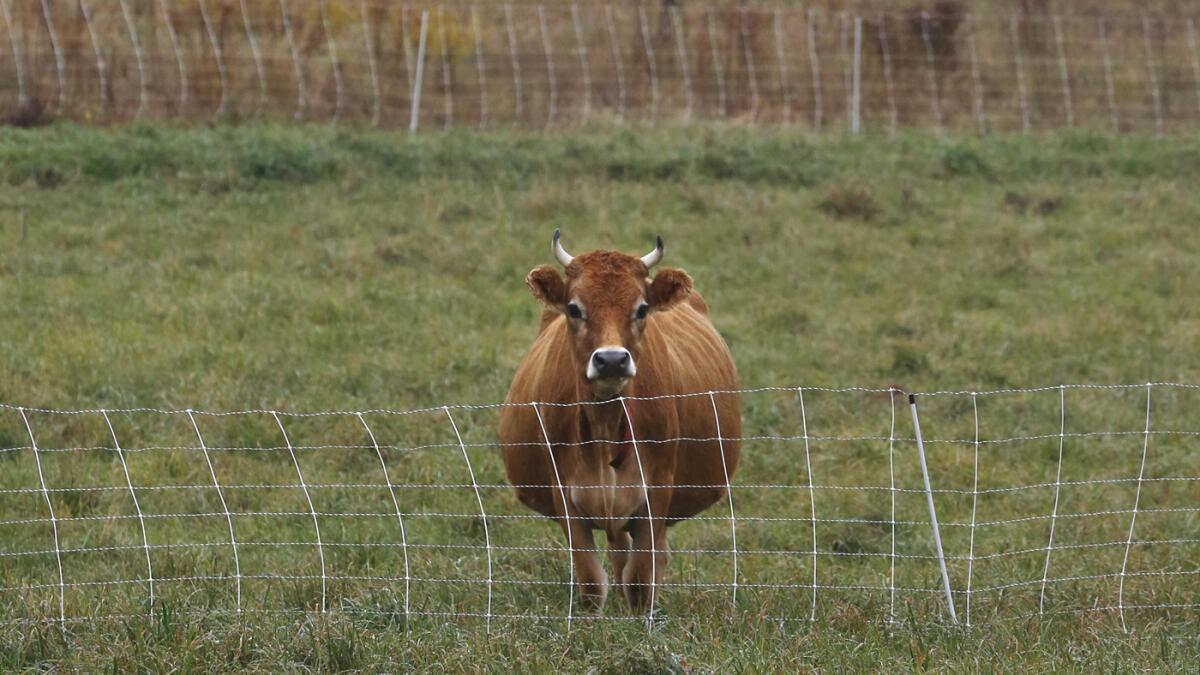Review: ‘Case for Sustainable Meat’ takes on many sacred cows

- Share via
When food guru Michael Pollan recently tweeted in support of Nicolette Hahn Niman’s new book, “Defending Beef: The Case for Sustainable Meat Production,” the protest that followed made it perfectly obvious why such a book is necessary. “A Cattle Rancher wrote a book about how free range, grass fed beef is better than factory farmed. Slow clap,” commented @FoodNetworkVeg.
But Hahn Niman’s mission is much bigger than that. If you are looking for a book to inspire fisticuffs at the Thanksgiving table, you’ve found it. Her “manifesto” calls for a revolutionized food system — one that requires cows. The co-proprietor of the famed Niman Ranch has not just extended the thesis of her pig book, “Righteous Porkchop,” to argue for a few pampered Bessies in today’s artisanal foods movement; rather, she’s saying here that nearly everything we accept as gospel about the negative environmental effects of cattle ranching, and the ill health effects of eating red meat, is wrong.
And further, that cattle are necessary to the restoration and future health of this planet and its people.
Hahn Niman has bit off a lot here. But as a trained biologist, former environmental attorney for Robert F. Kennedy Jr.’s Waterkeeper organization, the wife of rancher Bill Niman and, interestingly, also a vegetarian, she relishes the slugfest. “I come armed with data, and plenty of it …” she writes in the introduction, adding that “the basic agricultural and demographic facts are not in dispute.”
It’s a book of numbers, and in it she sets out to debunk just about everything you think you know. She starts, for instance, with the now commonly cited criticism that cattle cause global warming. That comes from a 2006 report by the U.N. Food and Agriculture Organization, which stated that 18% of all greenhouse gas emissions worldwide came from livestock and most of that from cattle. This number is still used, though it was dismissed even before Hahn Niman got to it. That same year, the Intergovernmental Panel on Climate Change, the gold standard of global warming monitors, said the emissions from all of farming, including tractors, agrochemical production, tillage, etc. was 10% to 12% of global emissions. The U.N. Environmental Program now states that the number for all of agriculture is 11%, and cattle would be a tiny percentage of that.
One after another, Hahn Niman skewers the, ahem, sacred cows of the anti-meat orthodoxy. Eating meat causes world hunger? No, livestock are critical food (and cash) for 1 billion global poor, many living where plant crops cannot be grown. Deforestation? Forests are cleared primarily for soy, almost none of which goes to feed cows. Red meat and animal fat are the cause of the current epidemic of cardiovascular disease? The 1953 Keys study that spawned this belief actually showed no causation between the two and pushed us into the deadly grip of trans-fats and the true killer: sugar. Overgrazing ruined the American West? No, it was improper grazing and, in some cases, not enough cattle.
I am glossing here, but Hahn Niman does not. She has you so deep in the minutia of studies that you’ll be gasping for air. Remember, she’s a lawyer, using plenty of “as I will show” and “as I have demonstrated” to make her case.
That case, the true subject of Hahn Niman’s book, is for grass. In a chapter titled “All Food Is Grass,” she writes, “Making grass, rather than chemicals and mechanization, the foundation of our food system is a massive but necessary shift.” Even as she excoriates the beef industry (her livelihood) for poor grazing and using growth hormones, among many other bad practices, she keeps coming back to her point that we need grass and that grass needs cattle.
Here Hahn Niman joins a swelling cadre of new books (“The Soil Will Save Us,” “Cows Save the Planet,” et al) extolling Zimbabwean grass advocate Allan Savory. His Holistic Grazing theory proposes that ruminants like antelope and bison — and now cows — create healthy grasslands when they’re kept by predators in tight “mobs” and constantly moved place to place, digging up the grass and leaving a steady stream of manure. Those grasslands thrive, preventing erosion of topsoil, which is one of our worst global environmental crises, sequestering massive amounts of carbon, and producing dense, nutrient-rich food from marginal lands. Moving those herds requires cowgirls and -boys, which also brings more jobs to farm country.
Of course, even the prospect of mitigating global warming or improving global health won’t persuade many vegetarians or vegans to start eating beef. Obviously Hahn Niman is fine with this. “But if your rationale is based on the environment or health, I think the reasons are poorly grounded,” she adds.
She’s not trying to change your mind; she’s trying to save your world. And if you’re an eater trying to pick your way through this divisive debate, you’re cheering the information on every page.
Kuipers is writer living in Los Angeles.
Defending Beef
The Case for Sustainable Meat Production
Nicolette Hahn Niman
Chelsea Green: 288 pp., $19.95 paper
More to Read
Sign up for our Book Club newsletter
Get the latest news, events and more from the Los Angeles Times Book Club, and help us get L.A. reading and talking.
You may occasionally receive promotional content from the Los Angeles Times.










